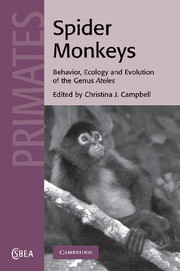Book contents
- Frontmatter
- Contents
- List of contributors
- Acknowledgements
- 1 Introduction
- Part I Taxonomy, phylogeny and evolution
- 2 Morphology and evolution of the spider monkey, genus Ateles
- 3 The taxonomic status of spider monkeys in the twenty-first century
- Part II Ecology
- Part III Behavior and reproduction
- Part IV Interactions with humans
- Index
- References
3 - The taxonomic status of spider monkeys in the twenty-first century
Published online by Cambridge University Press: 05 May 2010
- Frontmatter
- Contents
- List of contributors
- Acknowledgements
- 1 Introduction
- Part I Taxonomy, phylogeny and evolution
- 2 Morphology and evolution of the spider monkey, genus Ateles
- 3 The taxonomic status of spider monkeys in the twenty-first century
- Part II Ecology
- Part III Behavior and reproduction
- Part IV Interactions with humans
- Index
- References
Summary
Introduction
Spider monkeys are known by multiple names to local cultures, many of which reflect their acrobatic agility in the trees, or their various differences in coat color. Some indigenous groups also apply names that reference the blue eyes exhibited in some forms of spider monkey (Konstant et al., 1985). Within the scientific literature they occupy various positions in the taxonomic relationships among members of the Atelinae subfamily (see Rosenberger et al., this volume), and have been included in vast numbers of upper-level taxonomic surveys. It is thus surprising that their species-level taxonomic status has been the subject of only a few discriminate character-based investigations over the previous century.
Pelage variation in Ateles is substantial and has been the primary characteristic considered in previous categorizations of spider monkeys. Given the wide variation in coat colors among spider monkeys, it is not surprising that the first systematic study of Ateles taxonomy (Kellogg and Goldman, 1944) relied primarily on pelage. They initially identified four species and 16 different subspecies of Ateles (Kellogg and Goldman, 1944). These subspecies represent racially identifiable groups (Kellogg and Goldman, 1944) that can theoretically be identified based on a combination of different pelage characteristics. In this chapter, I provide a review of the various studies of spider monkey taxonomy and the scientific methods used to discern relationships.
- Type
- Chapter
- Information
- Spider MonkeysThe Biology, Behavior and Ecology of the Genus Ateles, pp. 50 - 78Publisher: Cambridge University PressPrint publication year: 2008
References
Accessibility information
- 7
- Cited by

